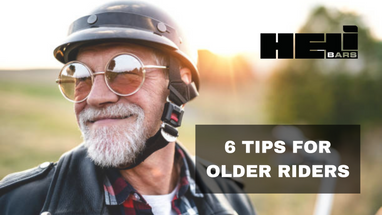Jun 16th 2022
6 Motorcycle Riding Tips for Older Riders
Greying hair, creaky knees, perhaps the need for a stronger eyeglass prescription – just a few of the many graces of aging. But just because there might be a bald spot hiding under your helmet doesn’t mean you can’t ride your motorcycle anymore.
Motorcycles are often associated with young people who are full of energy, fit as a fiddle and only interested in fulfilling their need for speed. But our community knows that in truth, riders come in all shapes, sizes, and ages. We know plenty of motorcyclists who are tearing up the road at 40, 50, 60 or even older. In fact, the median age of a biker in the US is 50 and a whopping 39% of motorcycle owners are between the ages of 51 and 69.
That’s not to say that no matter your age you can hop on a bike and ride into the sunset, no problem. Riding a motorcycle in a way that is safe and enjoyable takes effort at any age. It may be easy to forget that those skills and practices can change for aging motorcyclists. Your body’s needs and abilities require attention to keep you in the saddle well into your golden years.
We’re no stranger to the title of old motorcycle riders and for all you aging motorcyclists out there, we want to share our knowledge. Before you permanently stash your bike in the garage, listen up to these six tips for keeping your hands on the handlebars and the wind in your hair.
Warm Up Before a Ride
Singers have to warm up their voices, runners warm up their legs, and motorcyclists shouldn’t be any different. Before you embark on a long or fast ride, consider taking a few warm up laps around the neighborhood or in a parking lot. Warming up will give your body a chance to settle into a comfortable position and notice any twinges or misalignments that could turn into bigger problems once you’re on the road. A little practice will also wake up those biking muscles and start triggering your instincts—before you really need them. You can make any adjustments and better set your expectations for the kind of ride you can handle. As an added benefit, your engine and tires will also appreciate a little warm up. By setting aside a little time to get your senses ready before you really need to burst into action, you’re less likely to get hurt or just end up grumpy at the end of an uncomfortable ride.
Stretch Often & Exercise Regularly
If you curl your lip at the word “exercise” or “workout,” you’re not alone. But we’re not asking you to go on a run or start lifting weights at the gym at 6am. Lucky for us, riding a motorcycle (and enjoying it) doesn’t require a six pack. But it does require riders, especially aging motorcyclists, to keep in shape.
You can choose your preferred method of exercising, but one of the easiest ways to keep your muscles limber is by simply taking a walk every day. Walking to run some errands, get out into nature, or just make a few laps around your neighborhood can have great benefits in the long run and ensure your body is ready for your bike.
Like any sport or physical activity, riding a motorcycle uses a specific set of muscles and tendons. As you get older, incorporate stretches into your pre and post ride routines that focus on those muscles. Mainly, you want to stretch your wrists, shoulders, and hips where a lot of tension and tightness can build up from riding. Trainer, Adam Von Rothfelder, demonstrates 4 super simple stretches that work on each of these 3 important areas of your body in the video below.
Adopt a More Upright Riding Position
It should come as no surprise that your riding position affects your comfort and control on your bike. The style of bike you ride dictates what position your body is in. Sport bikes for example tend to have a forward-leaning position that can more quickly cause back pain and stiffness for old motorcycle riders. The best way to keep yourself in the saddle for years into the future is to find a riding position that is relaxed. Often, this means sitting with your spine perpendicular to the ground, your arms and wrists relaxed, and your feet planted firmly below you.
This makes Cruisers and Touring bikes particularly popular with aging motorcyclists, but that doesn’t mean you’re limited to these styles. Today’s motorcycle modifications market allows you to adjust the fit and positioning of many different bikes. Some of the most common and easiest adjustments you can make to achieve a more upright riding position include custom seats and handlebar modifications. Both help to alter your body’s relation to the foot pegs and handlebars. The more comfortable you are in your reach, the more control you can maintain on your bike. The way you ride should change as you and your body changes.
We’ve always believed that your bike should fit you, not the other way around, and this principle is especially important as you get older. To help you find that elusive comfort zone and give you more control as an older rider, we offer handlebar risers for a wide variety of bike models. Ever popular with aging motorcyclists, we have handlebars for the Harley Davidson Street Glide, the Honda Goldwing, and others. If you don’t see your bike model in our inventory, don’t despair! You’ll need to check a few things first, but our handlebars could still work to get you in a more upright riding position.
Consider Downsizing
You’re going to be a badass no matter what motorcycle you ride, so it might be time to consider transitioning to something other than the biggest and most powerful model. In reality, you probably aren’t going to be riding as fast or as far anyways. Bigger bikes require more strength to manipulate and safely make turns. You should also think about whether or not you could pick your current bike up if it fell over. Switching to a smaller, lighter model is a great way for aging motorcyclists to continue riding with safety in mind.
Take Safety & Practice Courses
Motorcycle courses aren’t just for beginner riders. Years of riding experience do make for knowledgeable riders with (generally) good judgement, but your reaction time and reflexes can decline over time. Not to mention safety standards and guidelines can change over the years. For aging motorcyclists who may have taken a break from riding for a few years and are looking to get back into it, safety and practice courses are a must. And even for all the long haulers that have been riding their bikes continuously, it really never hurts to periodically sign up for a basic MSF course or find a more advanced course offered by a local trainer. You can still teach an old dog new tricks.

Know Thyself
When it comes down to it, the best tips for motorcycle riders who are beginning to feel their years are about paying attention to their bodies and minds. You should always do your best to be aware of your current health issues and how they might affect your riding abilities. Declines in vision, hearing, and balance should not be taken lightly. It can be difficult to be truly honest with yourself when evaluating your aging body, but for your safety and the safety of others, these considerations are paramount to everything else.
Just because you’re experiencing the physical effects of aging doesn’t mean you have to stop riding cold turkey. But it does mean that you may need to adjust your behaviors. You might decide to bring a buddy with you more often or to shorten the length of your rides. If you find yourself feeling particularly out of sorts one day, don’t be afraid to cancel plans to hit the pavement. Make room for breaks if you plan to ride longer. Set yourself realistic expectations and you’re more likely to enjoy the riding experience than end up disappointed and exhausted.
Knowing yourself also applies to your confidence behind your handlebars. It can be dangerous to allow yourself to go on autopilot as an aging motorcyclist. Keep your physical and mental skills in check by following some of the other motorcycle riding tips we listed above.
This is also why practice and warming up are so important for older motorcycle riders. You should provide yourself with time and space to see how you feel on your bike. Choosing a safe, low-stress environment where you can get a good sense of how long it takes before you feel tired or get sore is a smart way to plan ahead for other rides. In the end, you’re the best expert on yourself and should regularly check in with how you’re feeling if you want to ride safely, confidently, and happily into your later years.
How Old is Too Old to Ride a Motorcycle?
If you haven’t already guessed, there isn’t one solid answer for what age you should stop riding a motorcycle. Just like every bike is different, every old motorcycle rider is unique. In the end, you need to make a call about when it’s time to give up biking according to your personal abilities. That said, there are a few signs that you shouldn’t ignore them.
- More close calls
- Problems concentrating
- Increased nervousness while riding
- Difficulty seeing traffic signs, lights, and road lines
- Chronic pain during and after riding
Remember, riding a motorcycle should be an enjoyable experience. Do the benefits still outweigh the downsides if it consistently causes you pain, stress and risks your safety? We’re a strong supporter of rider of all ages and abilities as long as you are making the choice that is right for you. If you do end up retiring from time on the road, know that your community of motorcyclists won’t disappear. And hey, maybe you can use it as an excuse to finally get that convertible instead!
If you count yourself as an old motorcycle rider and have some wisdom to share or tips that you use to stay in the saddle, we’re always taking suggestions. Shoot us an email with your hard-earned insights!

